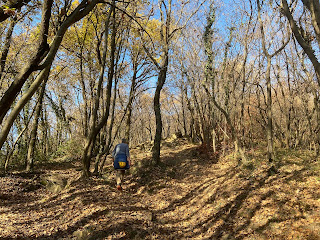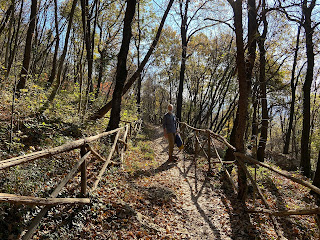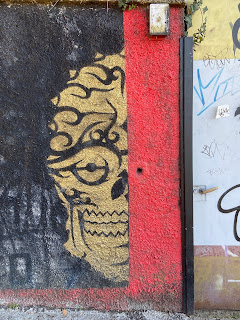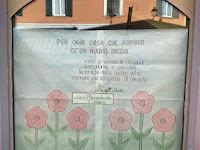Can we just say that the signs in this installment of Street Sign Language Lesson ™ totally prove the point in the post we wrote several years ago about how much writing in Italy – and by extension signs – is in uppercase. That post was
Lo Stampatello: How Italians Write.
In this 23rd installment, we have: four signs related to the coronavirus (closures and forbidden items during the lockdown), a sign for a lost cat (and a plea from its young owner), a sign about a poet incarcerated as an antifascist, a sign advertising what's cooking at
Il Coccio, and a sign on a van that takes us on a small diversion to learn about flooring. If this overview hasn't piqued your curiosity: close this window now, click your browser's back button, or go
here.
 INFORMAZIONE AI NOSTRI CLIENTI – In ottemperanza al DPCM del 3 Novembre 2020 non è temporaneamente consentita la vendita di questa categoria di merceologica.
INFORMAZIONE AI NOSTRI CLIENTI – In ottemperanza al DPCM del 3 Novembre 2020 non è temporaneamente consentita la vendita di questa categoria di merceologica.
Information for our customers: In accordance with the Prime Ministerial decree of November 3, 2020, the sale of this product category is temporarily not allowed. There's a lot to unpack here. DPCM is an acronym for
decreto del Presidente del Consiglio dei ministri and is a decree by the Prime Minister of Italy. Here the
DPCM in question is that of 3rd of November with its
attachments.
We know, we should know this cold, but we are a little shaky on our knowledge of how the Italian government works. Here goes an explanation: a
decreto (law-decree) is a type of law that the Prime Minister (also know as the premier) can enact that doesn't require legislative approval although that may come later with the Senate – the upper house (
Senato della Repubblica) and the Chamber of Deputies – the lower house (
Camera dei deputati). Law-decrees are usually used as instruments "in cases of the uttermost need and urgency", as in the cornavirus pandemic. Imagine trying to get laws enacted quickly with 5 or 6 different parties and the law-decree starts to make sense.
So how does this all apply to this Carrefour store suspending the sale of candles and cake decorating items? That's what we were wondering. To the best of our ability in interpreting the DPCM of the 3rd of November, stores in red zones (
zone rosse) can only sell essential items that appear in the attachments list (attachment 23). The list is inclusive not exclusive. That is, the items on the list are "essentials" and there is no indication of what can't be sold. Each (chain) store seems to have taken to deciding on what meets the decree as essential, which is a bit arbitrary. In some stores,
le candele e i diffusori per ambiente (basically ways to stink up your house with artificial smells) were marked not for sale. Okay, maybe this ban isn't so bad after all.

BAR PERRY: CHIUSO x (ZONA ROSSA) FINO AL? CIAO a TUTTI MÖLA MIA Bar Perry: (due to red zone restrictions) closed until? Hello everyone and never give up. X is often written for the preposition
per or "for". The question of the day is when will the restrictions be lifted.
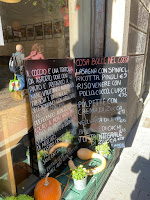 COSA BOLLE NEL COCCIO?
COSA BOLLE NEL COCCIO?
What's cooking at Il Coccio?
A
coccio is a terracotta / earthenware cooking pot or a fragment or shard of pottery. In our sign here,
Il Coccio refers to a trattoria in Bergamo. On the sign advertising the menu of the day, it begins with
Cosa bolle nel Coccio?.
Bolle comes from the verb
bollire – to boil or cook. It's an informal way of saying what's cooking. Here it becomes a pun of what's cooking and what's cooking in the pot.
Food at
Il Coccio during this time is for take-away only – like all other restaurants in Bergamo for most of November 2020.
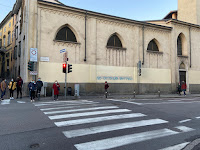
PER OGNI COSA CHE FINISCE C'È UN NUOVO INIZIO
For every ending, there is a new beginning.
A sign of the times: businesses closing during the pandemic. Here's a sign of one such business on via Santa Caterina that keeps the message positive. The sign continues anche se spesso le chiusure sono dolorose e, qualcosa ha termine nella nostra vita, è sempre una occasione di crescita – which translates approximately as "even if the closures are sad, and something ends in our life, it is always an opportunity for growth".
 INCARCERATO A BERGAMO PER ANTIFASCIMSO Imprisoned in Bergamo for being an anti-fascism.
INCARCERATO A BERGAMO PER ANTIFASCIMSO Imprisoned in Bergamo for being an anti-fascism. In 1943, the Italian poet
Salvatore Quasimodo (1901 – 1968) came to Bergamo from Milan on the invitation of
Giacomo Manzù (1908 – 1991). Because Quasimodo didn't respond to a draft card sent by the Repubblica di Salò, he was imprisoned for several months at La Rocca. Quasimodo's poem "
Dalla Rocca di Bergamo Alta" records his imprisonment and is inscribed on the shown here outside La Rocca.
In 1959, Quasimodo was awarded a Nobel Prize in Literature.
For a quick read on fascism and the connection to our time, check out the book
On Tyranny: Twenty Lessons from the Twentieth Century.
Finally, what does the Repubblica di
Salò have to do with this? It was the headquarter of the second and last incarnation of the Italian Fascist state, a sort of last gasp that functioned between September 1943 (when Italy rejected Mussolini and Germany seized control of northern Italy) and April 1945, as the tide turned definitively against the Axis powers in in Italy during WWII.

GATTO SMARRITO – Cerco il mio gattino. Si chiama Simon: è bianco, grigio, minuto.
Lost cat. I'm looking for my kitty. His name is Simon: he is white, gray, and small. This sign was written by a little girl who lost her cat. This sign just warms a cold pandemic and apathetic heart doesn't it? The sign includes what is probably her mom's cell phone. Come home Simon!
For the record:
gatto (
gatta) is a cat, and it sounds a bit like the French word
gâteau. A
gattino (
gattina) is a kitten. There is a famous 1960 song from Gino Paoli called "
La gatta" that starts "
C'era una volta una gatta", once upon a time there was a cat.
Video.

Pavimentazioni f.lli Filisetti. Posa Pavimenti e Rivestimenti – Bettoncini con pompe
Flooring by Brothers Filisetti. Laying of floors and coverings – Cement with pump. f.lli is a commonly used abbreviation for brothers or
fratelli.
Posa comes from the verb
posare – to lay out. That's all fine and dandy, but the word that caught our attention was
bettoncini. When we tried looking it up, we could only find it with one T as
betoncino/i. Did they spell it wrong?
The best definition we could find was on an engineering
forum:
betoncino is a type of cement with aggregates that don't exceed1.5cm, which seems to be used in restoration work on walls. Beyond that, please call f.lli Filisetti for an explanation and spelling. (This
surname is one characteristically found in the Bergamasco.)




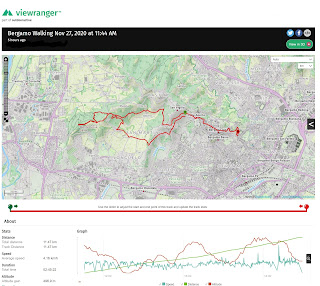








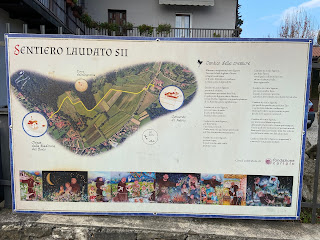






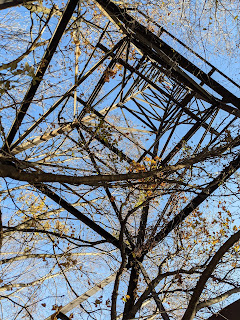
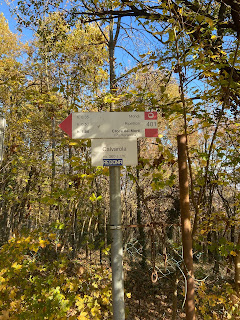
![[Asteraceae] Erigeron annuus - Eastern Daisy Fleabane (Cespica annua). [Asteraceae] Erigeron annuus - Eastern Daisy Fleabane (Cespica annua).](https://blogger.googleusercontent.com/img/b/R29vZ2xl/AVvXsEjTrHP86-X2UmvkEAsMQVCB6phuicIAF3PT58iN-ewEmNt1zhBNYnORxwedXIJLcwBbvgaR5UjUgcDTARJrVwRhgO0_lj1s-b7iXkw6B8QCx_n6w7UGzFtByYKMcwOJ_OWqtw05Qnol7vQ/s320/Tuesday+hike+-+Erigeron+annuus+-+Tall+Fleabane.jpg)
![[Dennstaedtiaceae] Pteridium aquilinum - Common Bracken (Felce quilina). [Dennstaedtiaceae] Pteridium aquilinum - Common Bracken (Felce quilina).](https://blogger.googleusercontent.com/img/b/R29vZ2xl/AVvXsEjtmwqU8J6hv4-6NtSsBpVi6drxSY3HNAoCwmo9zxZR8DBXTQUI9tvZKKOFRbbSeajqVYnHpjLFsQHOOiNBFSagO-lBn1GK2DnU780wuNsk8PJr09sOHhWDi7YCwKUAwivP4ZgqQmehxwk/s320/Tuesday+hike+-+Pteridium+aquilinum+-+Bracken+fern.jpg)
